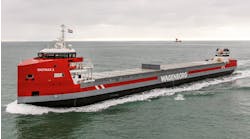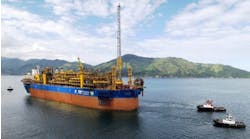Design targets smaller deepwater reserves
Kåre Syvertsen
Sevan Marine
Clovis Lopes
Sevan Marine do Brasil
The cost of producing petroleum through offshore facilities increases sharply as the water depths increases. In recent years, to ensure profitability in deep-water and ultra-deepwater fields, the size of processing plants and the number of risers have increased. The result is a number of large floating units capable of taking on big loads and offering large deck areas and storage capacities.
The increased size of floating units solves some problems but compounds others. Besides raising costs, due to the increase in steel weight and equipment, the big platforms bring about complexity in a new scale, demanding development of new technologies. These changes, in turn, add to the risks. The larger size also limits the number of available shipyards capable of delivering such a hull on time and on budget.
In a broad economic sense, with current technology and in waters deeper than 1,000 m, oil fields must have reserves greater than 300 MMbbl, of a crude lighter than ~20° API, to warrant development.
The first challenge, then, is how to exploit profitably the smaller accumulations located in remote deep water. The second challenge is the heavy crude case. Even when heavy oil is discovered in sizeable quantities, flow assurance is made difficult by the high crude viscosity and low water temperatures.
Sevan Marine is proposing a new type of floating support able to offer greater deck areas and load capacities along with storage and low motion characteristics for lower cost. The SSP – Sevan Stabilized Platform – concept relies heavily on two features for cost reduction. The features are omni-directionality to weather forces and a modular design, thanks to the concept's intrinsic symmetries.
The Sevan Stabilized Platform concept is basically a mono-hull with circular shape, depending on the same stability principles.
null
SSP
The mono-hull concept for offshore oil production, typified by the FPSO unit, is considered a lower-cost option for large, deep-water projects. This design is compared to other concepts, such as the semisubmer-sibles, TLPs, and spars. FPSOs have been in use throughout the world and are a well established technology. With the development of turret and swivel systems, FPSOs have proved reliable in harsher environments. In more benign environments, the preference is for more conventional spread-mooring FPSOs. These vessels are less expensive because they do not require turret or swivel. Among the FPSO's advantages are large storage capacity and high deck load. The downside is that FPSOs are sensitive to wave direction even in moderate seas.
The SSP concept is basically a mono-hull with circular shape, depending on the same stability principles. Unlike the spar design, the SSP hull is wider than it is tall, because the operational draft is typically less than a third of the diameter. The circular shape dispenses the unit of any heading changes, because the seas face the same vessel hydrodynamic resistance, whichever direction they are coming. Consequently, the SSP does not need turrets or swivels. This saves on fabrication and maintenance.
The characteristic dimension for the SSP is the diameter. This makes it a highly modular design, with the diameter determining the size of the platform. Sevan Marine has developed designs for three SSP sizes based on the required oil-storage capacities. From these, an intermediate size could be achieved. The SSP stability principles are the same as for a ship-shaped vessel. The large water plane area provides high stability, resulting in a large deck load capacity. The available deck area is large and can be increased with a cantilevered deck. This allows all activities to be conducted above deck, with cargo, ballast, and liquid supplies placed inside the hull for imp-roved operational safety. The internal tank layout places the ballast tanks at the SSP periphery, giving her a double-hull configuration.
SSP symmetrical shape allows access to all tanks, ballast, and cargo from a central compartment. Even with the possible adoption of a moon-pool, access can be made through ring main lines for water and oil. No piping is needed inside any of the tanks, which greatly simplifies the engineering design, construction, and operation. It is estimated that only around 30% of piping normally used in a conventional FPSO will be needed in the SSP. In addition, the amount of cabling will be reduced due to the compact design.
The SSP double hull is designed to maximize safety, both operational and environmental. The cargo tanks are protected by the ballast tanks to prevent leaks to the sea in the event of a collision. Further, the double hull has an important structural role, adding stiffness in combination with the upper deck and the central shaft, to which it is linked via vertical bulkheads and horizontal stiffener elements.
The overall result is a lighter steel weight that reduces construction costs. The cylindrical shape provides for much lower flexing moments being imposed on the structure, which reduces sagging and hogging, and makes for low fatigue stress levels. At the base of the SSP lies a bilge box that provides damping to the vertical and angular motions of the vessel. The bilge box is responsible for enlarging the vessel added mass and increasing the damping.
The Sevan Stabilized Platform is a new type of floating support, able to offer greater deck areas and load capacities, along with storage and low motion characteristics, for lower cost, the company says.
null
Motion behavior
The SSP hydrodynamic behavior has been extensively tested in the Marintek ocean basin, in Trondheim, Norway, where the SSP's excellent behavior for both angular and vertical motions has being verified. The tests simulated sea conditions in the North Sea and in Brazil, corresponding to extreme weather loadings and multidirectional seas. Both scenarios were investigated up to their 100-year storm conditions.
The SSP's response in pitch/roll motions was exceedingly small across the board. Angular motions are especially relevant for the operational efficiency of a process plant, which would need to be shut-down in cases of excessive roll angles. Large roll motions are responsible for fatigue-induced cracks in structures like long flare booms and large turret bearings. Roll motions increase vertical riser motions, when risers are positioned away from the geometrical center of the unit. Such a riser arrangement is common on semisubmersibles and spread-moored FPSOs.
In turret-moored FPSOs, high angular motions can induce high stress levels at the riser hanging points. The SSP heave response surpasses that of semisubmersibles a good range of the sea spectrum. Heave response is a significant consideration for steel catenary riser fatigue. SCRs are primarily sensitive to high frequency heave motions. These motions are found around 11.5-sec period. Model tests demonstrated that, with a suitable bilge box design, the SSP motions are well within the motion requirements to prevent SCR fatigue. The low motion behavior shown by the SSP not only increases the plant's efficiency and riser life, but also increases the overall operational safety levels.
Offloading
Offloading operations to shuttle tankers will be done by using two stations, positioned 180° from each other, and away from the accommodations. These are designed as reel type stations, with a small hawser winch at their side. Tests were conducted at Marintek with a conventional tanker size model, without DP. The results indicated that the tanker yaw motions were in general moderate or small, since the SSP surge and sway motions are much smaller than those for a ship-shaped vessel. This reduces the interaction between the two vessels during offloading operations, increasing the operational safety.
The high degree of hull symmetry in the SSP concept favors block modularity. The hull is made up of eight types of construction modules. With this design, construction will benefit from a learning curve effect, where the efficiency in block construction will increase as the work progresses. This fact, coupled with the absence of piping and cabling inside the tanks, simplifies the detailed design work, and lowers overall construction costs.
The SSP concept has a wide range of applications, from large units in deepwater, down to the production of small fields in shallow areas. The SSP concept offers a flexible solution that may be tailored for a large number of applications. The SSP may be used as a full-fledged ultra-deepwater FPSO. With a large number of risers, it may be used as a shallow water storage unit, for example, in combination with a fixed production platform or as a DP unit, designed for test production and/or early production. When operating as a DP unit, the SSP can use one or more drill-pipe risers, since it does not need to turn. A derrick for riser handling and well intervention, process plant, and storage facilities would be available for this type of operation. Due to the ease of construction, the SSP can be fabricated in a wide number of shipyards.
With the industry facing the ever-mounting costs for deepwater developments, the size of economically producible fields continues to grow. A less expensive design is needed to access the scores of smaller accumulations that represent idle investment and lost opportunities. The SSP is based on proven design principles and conventional steel fabrication. This concept increases efficiency across the board, from construction to operations, including safety and maintenance. ;
References
Brazil's Evolving Deepwater Risk Reward Profile by S.P. Thurston, and T.R. Bard. Proceedings of 2003 Offshore Technology Conference. OTC 15052.
Creating a Sustainable E&P Business in Brazil by J. Haney and M. Koot. Proceedings of 2003 Offshore Technology Conference. OTC 15054.
Effects of Fully Coupled and Quasi-Static Semi-Submersible Vessel Motions on Steel Catenary Riser's Wave Loading Fatigue by W. Ye, J. Shanks, J. Fang. Proceedings of 2003 Offshore Technology Conference. OTC 15105.
Technical Challenges for Offshore Heavy Oil Field Developments by C.D. Wehunt, N.E. Burke, S.G. Noonan. Proceedings of 2003 Offshore Technology Conference. OTC 15281.
Can Heavy Oil and Deepwater be Mixed? by J. Haney. Proceedings of 2003 Offshore Technology Conference. OTC 15282.
Authors
Kåre Syvertsen is vice-president of technology for Sevan Marine AS.
Clovis Lopes is new business development manager for Sevan Marine do Brasil.





